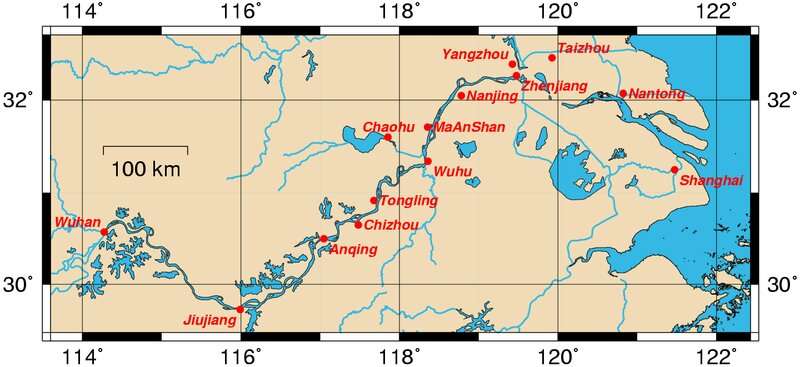This article has been reviewed according to Science X's editorial process and policies. Editors have highlighted the following attributes while ensuring the content's credibility:
fact-checked
trusted source
proofread
Factors affecting fish diversity patterns in middle and lower Yangtze River

Human-caused changes to landscapes and riverscapes have fundamentally impacted freshwater biodiversity patterns throughout the world's aquatic systems. Previous studies have shown that small- and medium-sized streams have experienced steep reductions, but there has been less focus on patterns and drivers of fish biodiversity in larger riverine systems.
The research team led by Prof. Chen Yushun from the Institute of Hydrobiology (IHB) of the Chinese Academy of Sciences, in collaboration with the Michigan State University, University of Washington, and International Joint Commission, demonstrated the roles of river-lake connectivity, wetland extent, and human stress factors in shaping patterns of alpha and beta diversity for migratory and nonmigratory fishes in the middle and lower reaches (MLR) of the Yangtze River. The results were recently published in Landscape Ecology.
In this study, the researchers examined the relationship between wetland extent, a suite of human stress factors, including urbanization, fishing pressure, navigation, and shoreline modification, and three classifications of fish assemblage data—all species, nonmigratory species, and migratory species—that were sampled along gradients of river-lake connectivity in Dongting and Poyang lakes.
Based on the distance between the sampling reaches and Poyang Lake or Dongting Lake, the researchers used clustering analysis to divide the sampling reaches into three segments, including MLR1, MLR2, and MLR3. MLR1 was situated nearest to Dongting Lake and further upstream. The area nearest to Poyang Lake was MLR2, which was situated in the middle. The MLR3 reach was the farthest from Dongting and Poyang lakes and was located further downstream.
To detect spatial fish diversity (alpha and beta) patterns in the middle and lower Yangtze River, the researchers conducted one-way permutational multivariate analysis of variance. The results showed that MLR3 had the lowest species richness and the greatest total beta diversity (dBC) compared with other two segments for both all species and nonmigratory species.
In addition, the researchers conducted redundancy analysis and distance-based redundancy analysis to facilitate mechanistic interpretations of associations between the explanatory variables and fish alpha and beta diversity. River-lake connectivity, wetland extent, and fishing pressure largely influenced fish alpha and beta diversity. Species nestedness was primarily associated with amount of wetlands, and exhibited the strongest associations with nonmigratory fish species. Turnover was primarily associated with river-lake connectivity (mainly Poyang Lake), especially for migratory species.
Fish diversity conservation in this large river ecosystem calls for protecting hydrological connectivity and wetland habitats, as well as reducing fishing pressure. The findings from this study will help better inform fish conservation efforts in the Yangtze River.
More information: Fangyuan Xiong et al, River–lake connectivity, wetland, and human stress factors shape fish diversity (alpha and beta) patterns in the middle and lower Yangtze River, China, Landscape Ecology (2023). DOI: 10.1007/s10980-023-01616-y
Provided by Chinese Academy of Sciences




















